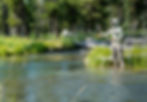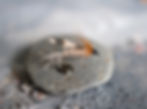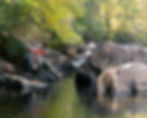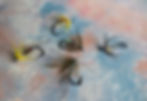Wet Flies: Tactics and Techniques for Multiple Fish Species
- Marc Fryt
- Dec 14, 2020
- 11 min read
Updated: Oct 10, 2023
If you have ever been confused by just what a wet fly is (aka soft hackle, spider, flymph, etc.) or why you should use them while fly fishing, you are not alone. Wet flies inhabit a strange and nebulous space in fly fishing tackle, but if there is only one word I could use to convince you to fish with them it is versatility. Below is a guide on what are wet flies, what do they imitate, how do you use them, techniques to use for multiple fish species, some equipment recommendations, and more.
(Also check out: How to Use Wet Flies - Rigging)

What are Wet Flies
The first thing to know is that wet flies are a category of fly, just like dries, nymphs, or streamers. At their most basic level they typically have sparsely tied bodies with long soft feather fibers that spider outwards. Beyond that, they can be tied with or without weight (using beads, lead-free wire, or tied on a heavy hook), they usually range in size from 10 all the way down to 18 or even 20, and have an endless variety of colors. You can use a wet fly just like a nymph, dry, or even a small streamer because they imitate so many things from aquatic insects to floating bugs or tiny baitfish. That is what makes them so versatile, in fact using wet flies is the oldest technique of fly fishing going back to at least the 15th century.
Wet flies are tied with those long feather fibers because it helps to impart small movements and liveliness into the fly, something that is just not feasible by trying to animate the fly yourself. The fibers can also trap air bubbles to make it look like an aquatic insect rising to the surface, and when the fibers pulsate it can take on the shape of a tiny fleeing baitfish. So, there really is no one thing that a wet fly imitates and we really do not know what a fish thinks it is, all we know is that they are effective and fun to use. You also cannot help but feel that they embody the art of fly fishing as well.

Why Should You Use Wet Flies
Simplicity
Using wet flies is probably the easiest form of fly fishing because there really is no right or wrong way to go about it. The frustrations of needing to get a dead drift or trying to keep the fly floating on the surface are all really unnecessary when it comes to wet flies. Cast a single wet fly into the water, let it float, sink, swing through the current, or just slowly retrieve it back, any of these techniques can work. That is why wet flies are great to use if you, or someone else, are new to fly fishing and just want to get out onto the water and not have to fuss with complicated nymphing set ups, indicators, perfectly drifting dry flies, and so on. On days that I just want to fish and relax to take in the surroundings there is no better way to do that than swinging wet flies through the current.
Covering Water
Wet flies are also effective if you want to cover a lot of water while you fish. Wading and swinging wet flies downstream is a great way to explore new sections of river to find where fish might be holding. It can be tough pinpointing just where fish are in a river or stream that you have not been to before, have not fished in a while, or when water conditions have changed. In cases like those, I like to think of swinging wet flies as my radar and when I start to locate where fish are I can then go back and try those spots with nymphs, dries, or streamers to catch a couple more.
(Be sure to check out this how-to article, Improve Your Skill at Reading Water for Fly Fishing: Riffles)

The Hatch
Before a hatch, aquatic insects (like mayflies and caddisflies) are moving up from the bottom of a river, stream, or lake and float through the water column until they reach the surface, hatch, and then fly away. It can be a long period before you start seeing any activity on the surface, but fish are still feeding on the insects subsurface. A wet fly imitates a rising aquatic insect beautifully and fish can really key in on this upward drift before the surface hatch. So rather than just sitting on the bank with my dry fly, waiting until I see rises on the surface, I will fish the river with wet flies to catch a few fish. This method also helps me to find out where a pod of fish might be so I can go back and fish that same area with dry flies during the hatch.
Which Fish Species Can You Catch Using Wet Flies
Wet flies are not just limited to catching trout (like brown, rainbow, or brook trout). Their versatility and range of imitations makes them a great addition to your fly box when fishing for smallmouth bass, panfish (like bluegill, crappie, and rock bass), creek chubs, carp, grayling, and perch. Wet flies are also incredibly useful while urban fly fishing because there are times when you might not know what fish species you will run into. Below, I will go over some techniques on using wet flies, but the good thing about these techniques is that they can be transferred from one species to the next.
(Be sure to also check out: How to Fly Fish Pocket Water- Targeting Trout Around a Single Boulder)

When to Use Wet Flies
Wet flies can be deployed any time of the year, yet I have found a few conditions where they really shine. The first is when a river or stream is low, clear and the fish are easily spooked (or they are hunkered under cover). Wading slowly downstream with a long leader (10-12ft) with a wet fly or two can be your best chance at hooking into something during these conditions. Spring creeks are notorious for these water conditions and there have been days that I only caught fish using wet flies.
Like I said above, before a hatch is a perfect time to swing wet flies through the current. Yet, they can also be used when you see fish rising. One thing that is effective is to find a fish or pod of fish rising to the surface and, rather than trying to drift a dry fly down to them, I will just slowly wade downstream to them swinging a wet fly gently in the current. All you need to do is estimate how far out your wet fly is and then inch it towards where the spot you saw the fish rising.
Another situation to use wet flies is after you have already fished through a section of river. Usually, I will fish upstream using dry flies or nymphs and when I turn around to head back down river I will tie on a wet fly or two. Since I have already waded through the water the fish will be pretty wary of anything, so it is advantageous to fish downstream with a subtle wet fly.

Techniques and Where to Use Wet Flies
Swinging Wet Flies and Leisenring Lift
The most straight forward way to use wet flies is swinging them. There are numerous techniques to swinging wet flies, but what I have found to be consistently effective is to cast your line downstream (at a 45-60 degree angle towards the bank), mend or pull in some line to reduce the amount of slack, and then allow the fly to gently swing through the current until it is in-line with you. Most bites come while the fly is nearing the end of its swing or while I am holding it directly downstream of where I am standing.

A more technical way to use wet flies is the Leisenring Lift (named after the fly fishing author James Leisenring). To do this, cast your fly slightly upstream and follow the fly with your rod tip, this will give the fly some time to sink a little. Once the fly has drifted past you, stop following it with the rod tip. At this point, the fly will begin to rise up through the water column and that is when you can most likely feel a strike. This technique is great to use when there is a fish directly across stream, or slightly downstream, of you.
With either of these techniques try using multiple wet flies, one weighted and one unweighted. This places the flies in different depths of water as some fish might be near the bottom or feeding somewhere mid-column. If you do not have weighted wet flies, the next best thing is to pinch on some split shot to you leader to help sink the flies.
While using these techniques, keep your rod tip slightly up. You will most often feel a fish strike when the fly is downstream of you. Having the rod tip slightly elevated acts as a shock absorber and reduces the chance of the fish popping off the fly or the tippet breaking. Also, when the fish does bite it typically is felt as a 'tick, tick, tick' followed by a solid pull. When this happens, keep the fly line pinched to the cork and allow the fish to hook itself. Once you feel the solid pull you can then raise the rod and start fighting the fish. If you raise the rod too soon you are essentially pulling the fly away from the fish's mouth.
Both the standard swing and Leisenring Lift are handy to use in front of boulders or log jams, through riffles, at the heads of pools, and along under-cut banks (especially on river bends). One of my favorite techniques is to swing a fly in front of log jams and then hold the fly in position just in front of the logs. Fish can be stacked up in these places and it is difficult to get any fly in front of their faces, but this technique seems to work best for me. I will also hold the fly in position for as long as I can while gently gliding the fly side to side in front of the logs.
Cast and Retrieve
When I am fishing lakes, ponds, reservoirs, or very slow rivers/streams the cast and retrieve is my go-to technique. It is as simple as it sounds but the speed of the retrieve should not be too quick. After casting your wet fly you can either allow it time to sink a little or begin to retrieve it back. Pull the fly back by using your fingers to gather the line up in your hand, this will keep the fly moving at a nice smooth pace in the water. When you do feel a strike, a simple strip set (just smoothly pulling on the line) is all you need to do, and once the fish is hooked you can raise the rod and begin fighting it.

This technique allows the fly to put those long feather fibers to work and animate itself even when there is virtually no current to move the fly. In cases where I find fish feeding or swimming around in calm water I will use a fly that I can see pretty well under the water (a fly with some color or flash). I will cast beyond the fish then slowly retrieve it back to me all while keeping eyes on either the fly or the fish.
If I am near a spot where fish are moving in and out of to feed then I will cast the fly out and just wait until I see the next fish come by and then gently retrieve the fly until the fish sees it. This is such a stealthy and fun way to catch a variety of species in lakes and ponds.
Other areas to cast the fly towards are reed beds, any sunken log or boulder, and out into the open water when there are insects hatching off the surface.
Using as a Dry Fly and High Sticking
Any wet fly that is not weighted is a candidate to use it like a dry fly. This is best done with a single wet fly and you should rub some dry fly floatant into the fly (or use desiccant powder). After casting the fly out, it will either ride on top of the current or just in the surface film, either way works. Follow the fly and at the end of the drift you can either cast again or let the fly be pulled under the water so you can swing it subsurface. I found that this method is most effective when the water's current is at a walking pace or slower.
When I come across picky fish that appear to be feeding on the surface, or just below, this technique can be the ace in the hole, and if they do not take the fly when it is floating then sometimes they will take it when it swings underwater.
If you are fishing pocket water around boulders or logs in a smaller stream or river then high sticking a wet fly can be more practicable. Find a spot that you want to fish and try to keep a boulder or log between you and the fish (so you remain somewhat hidden). Make a short cast out and hold the rod high in order to keep as much fly line off the water as possible. You can then let the wet fly drift naturally or twitch the rod slightly to animate the fly a little more. This technique can be done with both weighted and unweighted wet flies, and it is one of my favorite ways to fly fish the backcountry and the small streams I come across.

Equipment for Wet Fly Fishing
Just like the wet fly itself, the equipment is not complicated and can easily be tailored to fit the waters you fish. A 8 1/2 or 9ft fly rod that is anywhere from a 2-6 weight will work for wet fly fishing. The weight of the fly rod will be dictated more from the fish you are trying to catch, but I like to wet fly fish with as light a rod as possible so I can feel the subtle takes. A floating line is about all I use on rivers and ponds, but there can be times that an intermediate line is nice to have when fishing wet flies on the lake and you want the flies to sink deeper.
When swinging wet flies I like have leaders that are 8-10ft in length and taper down to 4-6x tippet. If I am trying to use the wet fly more as a dry fly (when going after fish that are easily spooked) then I will lengthen the leader to 9-12ft and taper it down to 5-7x; this still allows me to swing the wet fly after the drift without the leader becoming too cumbersome. Leaders for high sticking wet flies are pretty short, around 6-9ft tapered down to 4-6x.
(Also, check out: 7 Useful Knots to Know for Fly Fishing)

Final Questions About Wet Flies
Soft hackle vs wet fly what is the difference? I have been hunting for the answer on this question and have yet to find any convincing difference between what a wet fly and a soft hackle is. In short, it seems to be semantics and the two labels are used interchangeably. Wet flies can also be called 'spiders' and I have found that many 'spider' patterns almost always have very sparse bodies and very long soft hackle fibers (whereas wet flies can be incorporate more materials and bulk).
Some wet flies look like nymphs, some look like dries, and others resemble small streamers, so what is going on here? Well like I stated above, wet flies inhabit the space between the dry fly, nymph, and streamer. So there is a lot of cross-pollination going on and we end up with wet flies that have beads, are dubbed like a dry fly, have wings that look like small fins, and so on. You will even hear some people call a wet fly pattern a 'flymph' which is somewhere between a wet fly and a standard nymph. Again, the way I recognize a wet fly is when the fly pattern has those long soft feather fibers (i.e. soft hackle) at/near the head of the hook.
What hackles do you use to tie wet flies? Wet flies use long soft hackles rather than stiff hackle like you use for dry flies (like rooster saddles and capes). Feathers you can use are hen capes, grouse, partridge, starling, and woodcock to name a few. All of these feathers are soft and supple which will pulsate in the water and give life to the fly. Lots of traditional wet fly patterns are tied using partridge feathers but these can be difficult to come by and have jumped up in price. A great alternative are Whiting Brahma Hen Capes that have the same speckling of partridge but are far less expensive.
Finally, be sure to read How to Use Wet Flies - Rigging for in-depth instructions on setting up your leader for wet flies.
(Also, check out: How to Skin Game Birds for Fly Tying)

